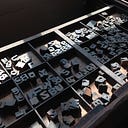I am very glad that the university offered this course. I must admit that I had a very specific preconceived notion of what it meant to be Southern and of all things that were Southern. However this course opened my eyes to a whole new world of Southern culture. As I began to explore the desegregation of Atlanta public schools I encountered several articles and magazine clippings, news reports and firsthand accounts of what it was like to grow up in segregated times.
But the fact that there was a presentation component to the project allowed me to think more critically about how I wanted to structure, organize, and deliver the information that I researched. I felt like presenting in a lecture format with a PowerPoint slide presentation, with accompanying photographs, allows the audience to actually feel as if they were a part of the presentation. If I were afforded the opportunity to continue nurturing and growing my project, I think that I would like to pursue that avenue of interviewing however many of the Atlanta nine, are still alive. I will want to get their first-hand accounts, of what it was like to be to go through the selection process, and their initial days of integration. I would also like to reach out to any and Lance city Council members or politicians, that were in office during that time to discuss policies and procedures just it prior to integration. Ultimately, I would like to conceive away, to turn this into a dissertation.
The biggest surprise regarding the course for me would have to be the very end lenses that you can use to view the South you can view it from an artistic standpoint, you can view it from a ethnic standpoint, you can view it from a cultural standpoint, the possibilities are endless. The biggest surprise in terms of my project would have to be that the state of Georgia essentially disregarded a federal mandate, and created its own sets of laws, to uphold segregation and prevents public schools within the state from integrating at the risk of losing funding and backing and even having the school closed down.
For me the biggest “ah-ha” moment had to be a tie between reading Confederates in the Attic and watching the documentary about Katrina from the young African American girl’s perspective and hearing how raw the experience was for her and her family. Confederates in the Attic taught me to look at the prospective of the person, simply put just because I think that the history of the Civil War is disgusting at best but was a necessary component considering the history of slavery and human suffrage. Yet there are people whom feel a genuine kinship to their history and their family’s role in the Civil War.
I think I was the most intrigued by Samuel’s project. It was unique and artistic and showed a completely different take on Southern and what that means. I loved the eerie works of art and the dark places that the artist’s were able to go with their photography.
As an educator I believe that the usage and exploration of all text genres is important as to encourage a well-rounded student.
I am a work in progress as it pertains to my view of southern culture and it representation to date. I am still learning how to embrace the south and its quirks and beauty.

